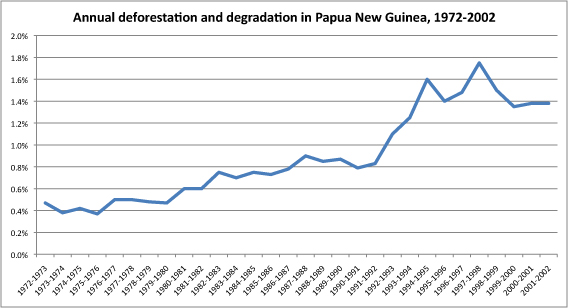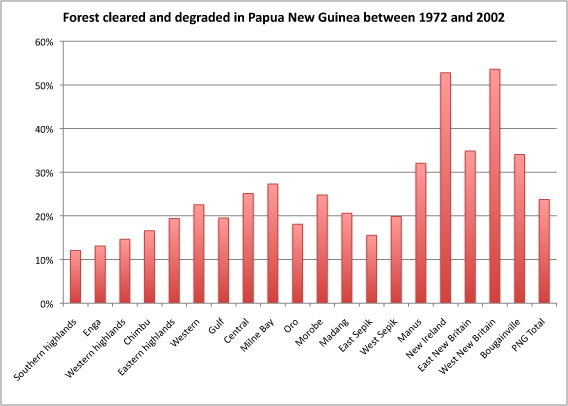|
|
Nearly one quarter of Papua New Guinea’s rainforests were damaged or destroyed between 1972 and 2002, report researchers writing in the journal Biotopica.
The results, which were published in a report last June, show that Papua New Guinea is losing forests at a much faster rate than previously believed. Over the 30-year study period 15 percent of Papua New Guinea’s tropical forests were cleared and 8.8 percent were degraded through logging.
“Our analysis does not support the theory that PNG’s forests have escaped the rapid changes recorded in other tropical regions,” write the authors. “We conclude that rapid and substantial forest change has occurred in Papua New Guinea.”
Deforestation and forest degradation in Papua New Guinea are primarily driven by logging, followed by clearing for subsistence agriculture. Since 2002 — a period not covered in the study — reports suggest that conversion of forest for industrial agriculture, especially oil palm plantations, has increased.

The study is based on comparisons between a land-cover map from 1972 and a land-cover map created from nationwide high-resolution satellite imagery recorded since 2002. The authors found that most deforestation occurred in commercially accessible forest, where forest loss range from 1.1 and 3.4 percent per year. Overall deforestation was 0.8 to 1.8 percent per year, higher than reported by the U.N. Food and Agriculture Organization (FAO), but lower than neighboring islands including Borneo and Sumatra. Overall Papua New Guinea’s primary forest cover fell from 33.23 million hectares to 25.33 million hectares during the period. 2.92 million hectares of forest were degraded by logging.

Dr. Phil Shearman, director of the University of Papua New Guinea’s Remote Sensing Centre and lead author of the paper, says that without incentives to keep forest standing, Papua New Guinea will continue to lose its forests.
“Forests in Papua New Guinea are being logged repeatedly and wastefully with little regard for the environmental consequences and with at least the passive complicity of government authorities,” said Shearman, noting that nearly half of Papua New Guinea’s 8.7 million hectares of forest accessible to mechanized logging have been allocated to the commercial logging industry.
Still there may be hope for the country’s forests. Papua New Guinea has become a leader in the push by tropical nations to seek compensation from industrialized countries for conserving forests as a giant store of carbon. The mechanism — dubbed REDD for reducing emissions from deforestation and degradation — could put billions of dollars annually towards conservation, sustainable development, and poverty alleviation.
“The government could make a significant contribution to global efforts to combat climate change,” said Shearman. “It is in its own interest to do so, as this nation is particularly susceptible to negative effects due to loss of the forest cover.”
U.N. studies have show that coastal communities in Papua New Guinea are particularly at risk from climate change.
Phil L. Shearman, Julian Ash, Brendan Mackey, Jane E. Bryan , and Barbara Lokes. Forest Conversion and Degradation in Papua New Guinea 1972–2002. Biotropica 10.1111/j.1744-7429.2009.00495.x
Related articles
Papua New Guinea’s rainforests disappearing faster than thought
(06/02/2008)
Logging is taking a heavy toll on the forests of Papua New Guinea, suggests a new study. Using satellite images to reveal changes in forest cover between 1972 and 2002, researchers from the University of Papua New Guinea and the Australian National University found that Papua New Guinea (PNG) lost more than 5 million hectares of forest over the past three decades — total forest cover declined from 38 million hectares in 1972 to 33 million hectares in 2002. Worse, deforestation rates may be accelerating, with the pace of forest clearing reaching 362,000 hectares (895,000 acres) per year in 2001. The study warns that at current rates 53 percent of the country’s forests could be lost or seriously degraded by 2021.
Papua New Guinea to ban log exports by 2010
(03/17/2008)
Papua New Guinea (PNG) will phase out log exports by 2010 said Forest Minister Belden Namah last month. The move comes as the country seeks to gain greater control over illegal logging and promote expansion of oil palm cultivation.
How activists and scientists saved a rainforest island from destruction for palm oil
(02/12/2008)
In mid-January, Mongabay learned that the government of Papua New Guinea had changed its mind: it would no longer allow Vitroplant Ltd. to deforest 70% of Woodlark Island for palm oil plantations. This change came about after one hundred Woodlark Islanders (out of a population of 6,000) traveled to Alotau, the capital of Milne Bay Province, to deliver a protest letter to the local government; after several articles in Mongabay and Pacific Magazine highlighted the plight of the island; after Eco-Internet held a campaign in which approximately three thousand individuals worldwide sent nearly 50,000 letters to local officials; and after an article appeared in the London Telegraph stating that due to deforestation on New Britain Island and planned deforestation on Woodlark Island, Papua New Guinea had gone from being an eco-hero to an ‘eco-zero’.